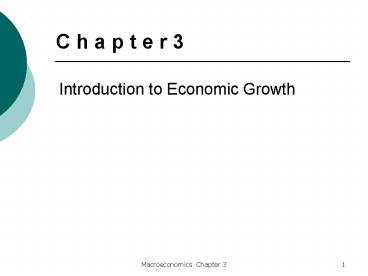Introduction to Economic Growth - PowerPoint PPT Presentation
1 / 45
Title:
Introduction to Economic Growth
Description:
C h a p t e r 3 Introduction to Economic Growth Economic Growth and Standard of Living World Distribution of Real GDP World Distribution of Per Capita income in 2000 ... – PowerPoint PPT presentation
Number of Views:227
Avg rating:3.0/5.0
Title: Introduction to Economic Growth
1
C h a p t e r 3
Introduction to Economic Growth
2
Economic Growth and Standard of Living
3
World Distribution of Real GDP
- World Distribution of Per Capita income in 2000
- World Distribution of Per Capita Income in 1960
- Growth Rate in Per capita Income 1960-2000.
- Income Inequality.
4
(No Transcript)
5
(No Transcript)
6
(No Transcript)
7
(No Transcript)
8
(No Transcript)
9
Long Term Economic Growth in OECD Countries
10
Productivity Slowdown
- The decline in the growth rate of real GDP per
person from 3.1 per year for 19601980 to 1.8
per year for 19802000 is sometimes called the
productivity slowdown.
11
Growth Questions
- What factors caused some countries to grow fast
and others to grow slow over periods such as 1960
to 2000? - In particular, why did the East Asian countries
do so much better than the sub-Saharan African
countries?
12
Growth Questions
- How did countries such as the United States and
other OECD members sustain growth rates of real
GDP per person of around 2 per year for a
century or more?
13
Growth Questions
- What can policymakers do to increase growth rates
of real GDP per person?
14
Production Function
- Y A F(K, L)
- A ? Technology Level
- K ? Capital Stock machines and buildings used
by business. - L ? Labor Force number of workers
15
(No Transcript)
16
(No Transcript)
17
Production Functions
- MPL Marginal Product of Labor
- Diminishing Marginal Product of labor
- MPK Marginal Product of Capital
- Diminishing Marginal Product of Capital
18
Constant Returns to Scale
- Constant Returns to Scale
- Double K and L and Y will also double
- Therefore, if we multiply K and L by the quantity
1/L we also multiply Y by 1/L to get - Y/L A F(K/L, L/L)
19
Per Worker Production Function
- yf(k)
- y ? output per worker
- k ? capital per worker
20
(No Transcript)
21
An example Cobb-Douglas Production Function
22
Contributions to GDP Growth
- ?Y/Y ?A/A a(?K/K) ß(?L/L)
- The growth rate of real GDP, ?Y/Y, equals the
growth rate of technology, ?A/A, plus the
contributions from the growth of capital,
a(?K/K), and labor, ß(?L/L). - Solow residual
23
Contributions to GDP Growth
- a ß 1
- Share of capital income (a) share of labor
income (ß) 1 - ?Y/Y ?A/A a(?K/K) ß(?L/L)
- 0 lt a lt 1
- 0 lt ß lt 1
24
Solow Growth Model
- Model ignores
- Government
- No taxes, public expenditures, debt, or money
- International Trade
- No trade in goods or financial assets
25
Solow Growth Model
- Labor force, L ( labor force/ population)
population - Labor-force participation rate
- Assume labor force participation rate is
constant. - Labor force growth rate is the population growth
rate
26
Solow Growth Model
- Growth rate in population
- We assume that population grows at a constant
rate, denoted by n, where n is a positive number
(n gt 0). - ?L/L n
27
Solow Growth Model
28
Solow Growth Model
- Assume ?A/A 0
- ?Y/Y a(?K/K) (1-a)(?L/L)
- The growth rate of real GDP is a weighted average
of the growth rates of capital and labor.
29
Solow Growth Model
- From the per worker production function
- ?y/y ?Y/Y - ?L/L
- ?k/k ?K/K - ?L/L
30
Solow Growth Model
- ?Y/Y a(?K/K) (1-a)(?L/L)
- ?Y/Y a(?K/K) - a(?L/ L) ?L/ L
- ?Y/Y - ?L/L a (?K/K - ?L/L)
- ?y/y a(?k/k)
31
Solow Growth Model
- Each household divides up its real income in a
fixed proportion s to saving and 1 - s to
consumption ( C ). - Capital depreciate at the same constant rate d
- dK is the amount of capital that depreciates each
year
32
Solow Growth Model
- Real saving s (Y -dK)
- Real saving (saving rate) (real income)
33
Solow Growth Model
- Y-dKCs(Y-d K)
- Real income consumption real saving
34
Solow Growth Model
- Y C I
- Real GDP consumption gross investment
- Y-dK C (I-dK)
- Real NDP consumption net investment
35
Solow Growth Model
- Cs(Y-dK) CI-dK
- or
- s(Y-dK) I-dK
- Real saving net investment
36
Solow Growth Model
- ?K I-dK
- Change in capital stock gross investment -
depreciation, - or
- Change in capital stock net investment
- ?K s(Y-dK)
- Change in capital stock real saving
37
Solow Growth Model
- Divide both sides by K
- ?K/K sY/K - sd
38
Solow Growth Model
- ?k/k ?K/K - ?L/L
- ?k/k s (Y/K) - sd - n
39
Solow Growth Model
- Y/K (Y/L) / (K/L)
- Y/K y/k
40
Solow Growth Model
- ?k/k s(y/k) - sd - n
- ?y/y a(?k/k)
- ?y/y a s(y/k) - sd - n
41
Solow Growth Model
42
Solow Growth Model
43
Solow Growth Model
- steady state.
- When k k, ?k/k equals zero.
- ?k/k 0, k stays fixed at the value k.
- y f(k)
44
Solow Growth Model
45
Solow Growth Model
- In the steady state, ?k/k equals zero.
- s(y/k) - sd - n 0
- s(y -d k) nk
- Steady-state saving per worker steady-state
capital provided for each new worker































